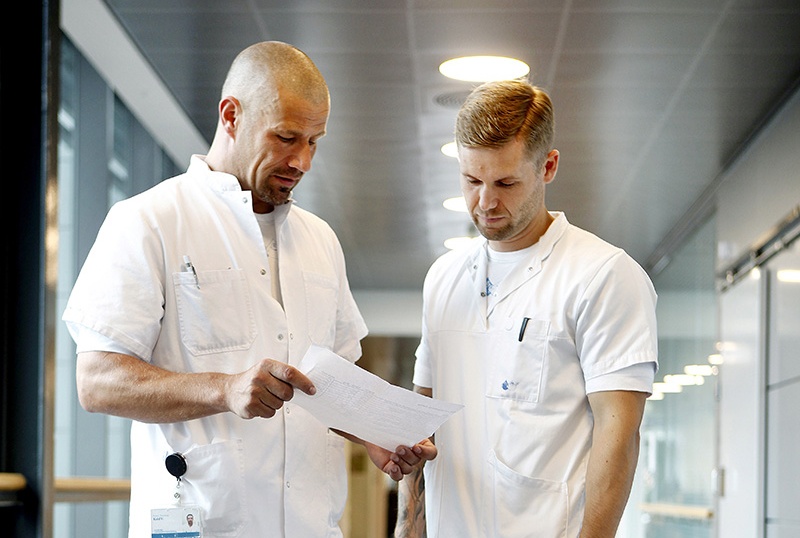A user-friendly and intuitive system
Overview of own and colleagues’ tasks
Better overview of tasks and capacity creates transparency
Optimised workflow
Increased patient safety

Many hospitals have the potential of making the coordination and execution of the porters’ tasks more efficient. Often, a so-called dispatcher is responsible for distributing the service tasks of the hospital, and the telephone, which is the primary method of contact, is in use. This means that bottlenecks occur in relation to booking and distribution of service tasks, which results in an inefficient workflow and increased waiting time.
Previously, Bispebjerg Hospital has also experienced problems in connection with the distribution of tasks and there has been a limited overview of porters and their tasks. Often, this has resulted in a lot of steps between tasks, where a porter has returned from a task empty-handed or has had to walk back to the department to get the next task. This has created increased waiting time and made patient service less efficient.
To strengthen the coordination and execution of service tasks, Bispebjerg Hospital has chosen to invest in Systematic’s Columna Flow. On the way, the hospital’s focus has been on involving the employees to examine how the daily work of porters can be made more efficient in order to increase patient safety.
"It is nice to be able to let the task go when it has been booked and then pay full attention to the next patient"
- Orderly, Bispebjerg Hospital

The Task Management system is one of the modules, which make up Columna Flow. With the system, hospitals get the necessary overview in order to optimise and make the service field more efficient. The solution provides users with the opportunity to see where staff, equipment and tasks are located, and what the statuses of the various tasks are. In this way, the individual task can be solved by the nearest porter. The result of this is that tasks are carried out faster and service staff have to walk fewer steps per task. Therefore, healthcare staff does not need to contact the porter or dispatcher to get an update, which means fewer interruptions and less time wasted. Overall, a higher level of transparency and documentation of service tasks is reached, which contributes to an improvement of quality logistics, delivery safety, and optimisation of the service department.
At Bispebjerg Hospital, Columna Flow has contributed to a change of culture. Here, the porters experience a high level of independence as well as faster and more flexible help from colleagues. This gives the porters a better opportunity for engaging with patients during e.g. transport, as they are not interrupted along the way.
At Bispebjerg Hospital, the porters are divided into groups that take tasks from the same task pool, which means that they can easily help each other. When porters are away from the department, they can take on tasks throughout the entire hospital based on the subsidiarity principle and via a feature showing the nearest tasks. Thus, porters are no longer limited to a small section of the hospital and during peak times, they are able to join other work groups.
Through the open structure in Columna Flow, the porters are able to work across both functions and tasks. The hospital employees ordering porter tasks, such as nurses, no longer have to book tasks via the telephone, as tasks are sent directly to all relevant porters and not just the local one. Columna Flow and its new and systemised workflow have therefore resulted in a change of the workflow for porters at Bispebjerg Hospital.
Because of the change of culture, the bookers of tasks are experiencing a far better task flow, since more porters now have the opportunity to take on any given task. This contributes to a better follow-up as the booker now receives a status on the task, one of the porters tells:
“It is nice to be able to let the task go when it has been booked and then pay full attention to the next patient – and I know who takes care of the task.”
An intuitive and user-friendly user-interface has made the booking procedure simpler for the people booking the tasks and at the same time, the task and status overview gives a better overview during handover among the porters at the hospital.
The porters are experiencing a higher level of calmness because they are not interrupted in the middle of their work. Now, the individual porter is able to contribute to the task flow by setting up tasks themselves. Columna Flow includes a tool for documenting the porters’ daily work, which helps visualising workloads and bottlenecks, leading to optimised work planning at the hospital. This has made it easier for the staff at Bispebjerg Hospital to improve the work planning so that the number of porters match the demand for capacity.
However, the solution benefits more than the service staff. In the end, patients will experience a higher level of service and safety, since strengthened coordination and planning leads to porters being able to provide a more patient focused service.
Users: porters, secretaries, nurses, doctors